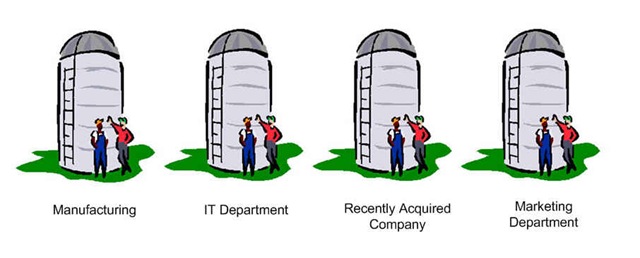When the managing partners of Boston-based Creative Realities, Inc. ask executives, “What is the number one innovation killer at your company?” one of the first words they always hear — always — is “silos!”
The term “silo” was created to indicate a similarity between grain silos that separate one type of grain from another and the segregated parts of a company. In a company suffering from silo syndrome, each business unit or function interacts primarily within its own “silo” rather than with other groups across the company.
The problems of “silos” show up in duplication of cost and effort, working at cross purposes, lack of synergy, little knowledge transfer or economies of scale. The largest problem, however, is a lack of alignment with the overall company strategy.
Acting in the interest of the silo, not the company
And the bigger the company, the more harmful a role silos play. Silos create an environment where sharing and collaborating is virtually impossible.
Those in charge of specialized knowledge often embrace the belief that “knowledge is power” and erect silos to protect their turf. They act primarily in the interest of their own silo — not the company.
As an article in Fast Company says:
Human nature forces people to want to do the best they can within their own ‘sandbox’ at the expense of everybody else. ‘Owning’ a function or a part of a business naturally brings forth a manager’s entrepreneurial spirit, and you don’t get to be head of a silo without being competitive. Managers rationalize their lack of cooperation as ‘I’ve been given this area to run as I see fit … “
The result of this thinking is bad enough when it is kept within a company, but when it spills over into customer relationships it can be disastrous. One company that I know of had five global business units (BUs for short), each with different products. Several of their biggest customers were in Japan. The customers were hounded by corporate VPs of the BUs calling and wanting to schedule visits — usually all within the same week.
 The customers, no doubt, were left thinking how disorganized the company was. The only way it was resolved was by giving the scheduling task to someone in the company’s Japan office. All BUs had to go through this person to schedule appointments with customers.
The customers, no doubt, were left thinking how disorganized the company was. The only way it was resolved was by giving the scheduling task to someone in the company’s Japan office. All BUs had to go through this person to schedule appointments with customers.
Lessons we can learn from Malaysia
Another example occurred in Malaysia. There were 60 employees representing four BUs co-located in the same office. The management of one BU decided it would be a nice gesture to give each of their employees a day off on his/her birthday.
When announced, the employees in the other BUs were upset. Here we had one BU making a unilateral decision without thinking of the impact on the rest of the office.
This last example started me thinking. How could this BU not have thought of the impact of adding this new benefit? Then I realized: At the headquarters’ location, each BU was in a separate building. They did not interact, never saw one another and obviously never socialized. The only interaction was when the VPs of all the BUs met at the CEOs staff meeting every two weeks. For all practical purposes, they worked for different companies.
In Malaysia, however, as with all the other offices throughout the world, the number of employees was small and they all were located in the same office. They all knew each other, went to lunch together, and socialized after hours. Unlike the isolated BUs at headquarters, each office was a closely knit group.
When everybody in a company — or in this case, a location — knows everybody else, informal relationships naturally develop and stepping across the lines drawn on an organizational chart is easy. Knowledge is shared and problems across silos are more easily recognized, discussed and resolved.
5 steps tp break own the walls
In order to correct silo problems, there is no need to re-organize the entire company. Here are 5 steps that can help break down walls and allow “cross-pollination” —
- Encourage cross-BU and cross-functional teams to work on company-wide problems. Employees get to know each other, gain exposure to other areas of the company and perhaps even accept assignments in other BUs or functional areas.
- Eliminate formality in the company and the need to go through an endless chain of command before engaging leaders.
- Establish common platforms and systems across the company and give people access to the same data and information. This discourages information hoarding.
- Design comfortable space in each building or on each floor where cross-functional teams can come together in a relaxed setting to brainstorm products/services, processes, and work cross-functionally to create solutions.
Well, it looks like I can’t think of #5. What would be your suggestion?
